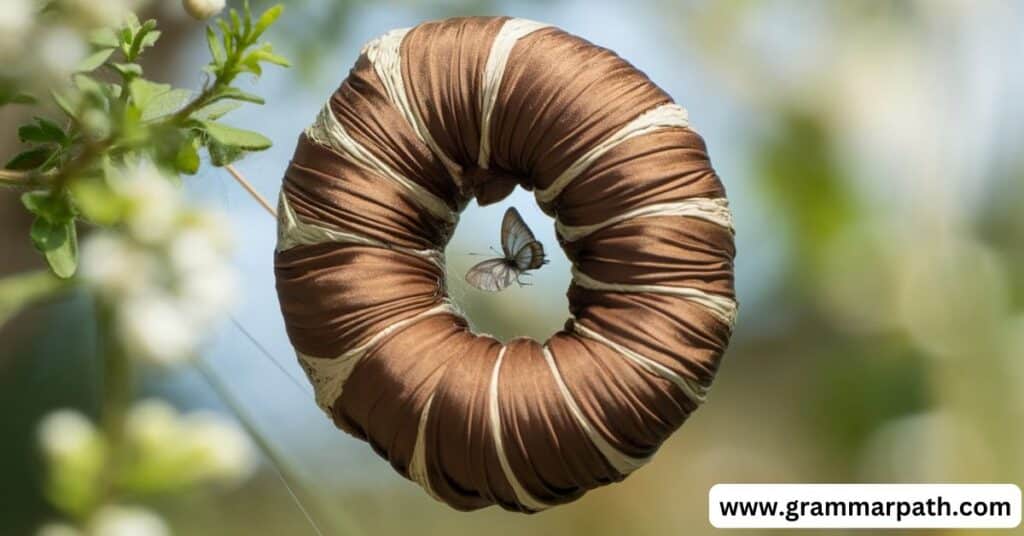
Cacoon or Cocoon: Which Spelling is Correct?
Cacoon or Cocoon which is the correct spelling? Cocoon is the accurate form, describing the silken casing that insects, especially moths and butterflies, create during metamorphosis. This protective cocoon is essential in entomology, as it provides shelter while the insect transforms. In metaphorical language, being in a cocoon suggests a period of personal growth, safety, or introspection.
The misspelling “cacoon” appears often due to phonetic spelling habits. Interestingly, cacoon is also a recognized term in botany, referring to certain medicinal plants in Caribbean regions. While these words might sound alike, their meanings and their correct applications are distinct, highlighting the significance of precise spelling for clear communication.
The Root of Confusion: Why Do People Mix Up Cacoon and Cocoon?
Misspellings like “cacoon” arise due to English spelling irregularities. Despite their similar sounds, “cocoon” follows a less intuitive spelling, which can easily trip up writers and English learners alike. Phonetic spelling, where people spell words the way they sound, often leads to variations like “cacoon.” In emails or texts, it’s common to see people accidentally writing “cacoon,” especially if they rely on phonetics rather than memorized spelling rules. Understanding this spelling confusion helps to recognize how English learning can sometimes take unexpected turns.
Cocoon: The Correct Spelling and Its Rich Meanings

The word cocoon is the correct spelling, and it has a long history in both science and language. A cocoon is a silken case spun by moths, butterflies, and other insects to protect themselves during the insect metamorphosis process. In addition to its scientific meaning, “cocoon” has come to symbolize security, growth, and personal transformation. For instance, if you are writing an email to a friend and want to describe a time of reflection, you might say, “I feel like I’m in a bit of a cocoon, working on myself.” Here, the term takes on a metaphorical depth that resonates with readers or listeners.
Cocoon Definition in Entomology
In entomology, cocoons play a vital role in the life cycle of many insects. For example, silk moths spin cocoons that protect them as they undergo metamorphosis from larvae to moths. These cocoons are carefully studied in entomology research, as they provide insight into insect development, adaptation, and survival. Cocoon formation has fascinated scientists and inspired entire industries, such as the silk industry. For a biologist writing a report, understanding and using the term “cocoon” correctly is essential for scientific accuracy.
The Science Behind Cocoon Formation
From a scientific perspective, cocoons are marvels of insect protection. They shield the insect from predators, environmental hazards, and other threats during its most vulnerable stage. Cocoons are not merely protective cases; they are lifelines that ensure the safe passage of the insect from one life stage to another. This incredible transformation process speaks to the resilience and adaptability of nature, which makes the cocoon a profound biological structure.
Cocoon in Metaphorical Context
The cocoon metaphor is often used to describe personal growth, resilience, or periods of solitude necessary for transformation. For example, someone might say, “I’ve been in a cocoon these past months, working on my goals.” Here, the word “cocoon” suggests a time of personal metamorphosis that will lead to positive changes. The symbolism behind cocoons is rich in metaphorical meaning, making it a powerful word choice in both casual and literary language.
Quick Summary:
“Cacoon vs. Cocoon” explores the common misspelling “cacoon” and the correct spelling “cocoon,” explaining its meaning in entomology, symbolism, and other contexts. 🐛🦋 It highlights the confusion caused by phonetics, regional variations, and the significance of the term in insect metamorphosis and personal growth. 🌱 The article also discusses the role of cocoons in nature, culture, and technology, emphasizing the importance of spelling accuracy in communication. ✍️
Cocoon in Popular Culture
In popular culture, the idea of a cocoon frequently represents themes of transformation and rebirth. Movies, books, and other media use the cocoon as a symbol of profound change. For instance, in certain coming-of-age films, characters undergo a cocoon-like phase where they withdraw from society only to emerge stronger. This usage demonstrates the metaphorical significance of cocoons beyond their scientific origins.
Cocoon in Technology and Design
The term cocoon has even influenced technology and design, where products or concepts are inspired by its protective and transformative qualities. For instance, “cocoon chairs” are designed to provide a safe, enclosed space for relaxation. These designs mimic the idea of a cocoon, highlighting comfort, security, and introspection. In technology, cocoon-inspired designs can be seen in apps and platforms that promote mental well-being or self-care.
Cacoon: The Misspelling and Its Unexpected Twist

Although cacoon is a misspelling, it has occasionally found usage in certain contexts, particularly in botany and regional language. This misspelling has persisted enough that some might even view it as a distinct term. In emails or written messages, you might see “cacoon” used as a nickname or playful term, even though it’s technically incorrect.
Cacoon as a Botanical Term
In botany, “cacoon” sometimes refers to specific plants, particularly in Caribbean and Central American cultures. Here, “cacoon” is not simply a misspelling but a valid botanical term, often associated with medicinal plants used in traditional healing. This distinct usage shows how regional dialects can shape the evolution of words in the English language.
Traditional Medicinal Uses of Cacoon
The term cacoon is sometimes used in reference to plants known for their medicinal benefits, such as the Jamaican cacoon plant. This plant is valued in traditional medicine for its purported health benefits, highlighting how spelling variations can evolve into terms with cultural significance. For instance, in a wellness blog, you might find references to the health benefits of the “cacoon plant.”
Cocoon vs. Cacoon
| Term | Correct Usage | Field |
|---|---|---|
| Cocoon | Insect metamorphosis case | Entomology |
| Cacoon | Medicinal plant (regional usage) | Botany |
The Impact of Misspelling: Why Correct Spelling Matters
Correct spelling enhances clarity and credibility in communication, especially in professional or academic settings. Misspellings like “cacoon” can detract from the meaning or, in some cases, suggest a completely different concept, as with the cacoon plant. Ensuring correct spelling is key to maintaining a professional tone and avoiding confusion.
Pro Tips:
The most important section in this article is “The Root of Confusion: Why Do People Mix Up Cacoon and Cocoon?” This paragraph addresses the main reason for the common spelling confusion and sets the foundation for understanding the differences between “cacoon” and “cocoon.” Readers benefit from knowing why certain words are frequently misspelled and how phonetics or regional variations influence these errors. This section engages the reader with relatable explanations and serves as the basis for understanding the entire article’s focus on spelling and usage.
Fascinating Facts About Cocoons in Nature
Cocoons are more than just protective casings—they offer fascinating insights into insect life cycles. For instance, a single silkworm cocoon can produce up to a mile of silk! Facts like these make cocoons an endless source of wonder in nature.
The Evolutionary Significance of Cocoons

From an evolutionary standpoint, cocoons are essential for survival and adaptation in the insect world. By studying cocoons, scientists learn about the ways insects protect themselves and ensure the survival of their species.
Tips for Remembering the Correct Spelling
Remembering that “cocoon” has a double “o” can help avoid the common mistake of writing “cacoon.” Visual reminders, mnemonics, and practice can aid in mastering this spelling.
Case Study: The Silk Industry and Cocoons
The silk industry relies on cocoon harvesting for silk production. Learning about cocoon development in this industry highlights the role of correct spelling for scientific and business contexts.
The Future of Cocoon-Inspired Technology
From personal wellness spaces to AI, cocoon-inspired technology is evolving. As this trend continues, understanding the symbolism behind the cocoon will remain relevant in design and innovation.
Frequently Asked Question
How do you spell cacoon or cocoon?
The correct spelling is “cocoon.” “Cacoon” is a common misspelling. A cocoon is a protective casing created by certain insects, especially butterflies and moths, during the pupal stage of their life cycle.
What is the American spelling of cocoon?
The American spelling of “cocoon” is the same as in British English: “cocoon.” There is no difference in spelling between American and British English for this word.
What is the proper name for a cocoon?
The proper name for a cocoon depends on the context, but it generally refers to the protective covering spun by certain insects, especially moths and butterflies, during their pupal stage. In a more technical sense, the cocoon is sometimes referred to as a pupal case or chrysalis (specifically for butterflies, although “chrysalis” is often used for the stage within the cocoon).
However, cocoon is the widely accepted and proper term for the silk or protective structure created by various insects like moths and other larvae during metamorphosis.
Conclusion
In conclusion, cacoon or cocoon may sound similar, but only cocoon is the correct spelling for the protective case spun by insects like caterpillars during metamorphosis. Cacoon is a common misspelling that can confuse readers, especially in entomology and other scientific contexts.
However, “cacoon” has its own identity in botany, referring to certain medicinal plants. Understanding these differences helps ensure accurate usage in both scientific and metaphorical contexts. Ultimately, spelling matters, especially when it clarifies meaning and enriches our understanding of language and nature.

Emily Olivia is an experienced writer specializing in grammar and English language topics. With a passion for clarity and precision, she shares valuable insights on synonyms, grammar rules, and writing tips to help readers enhance their language skills on Grammar Path.





